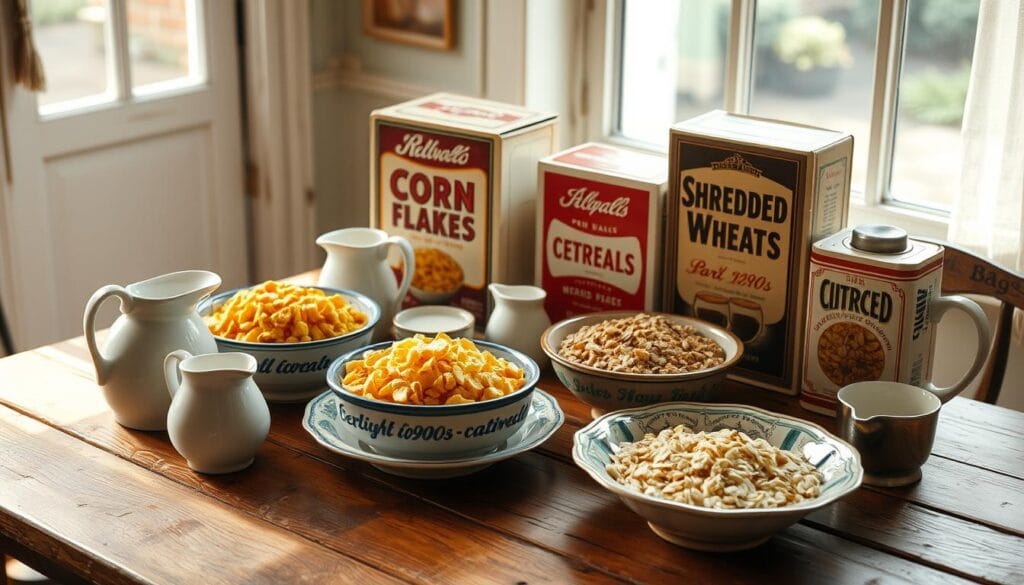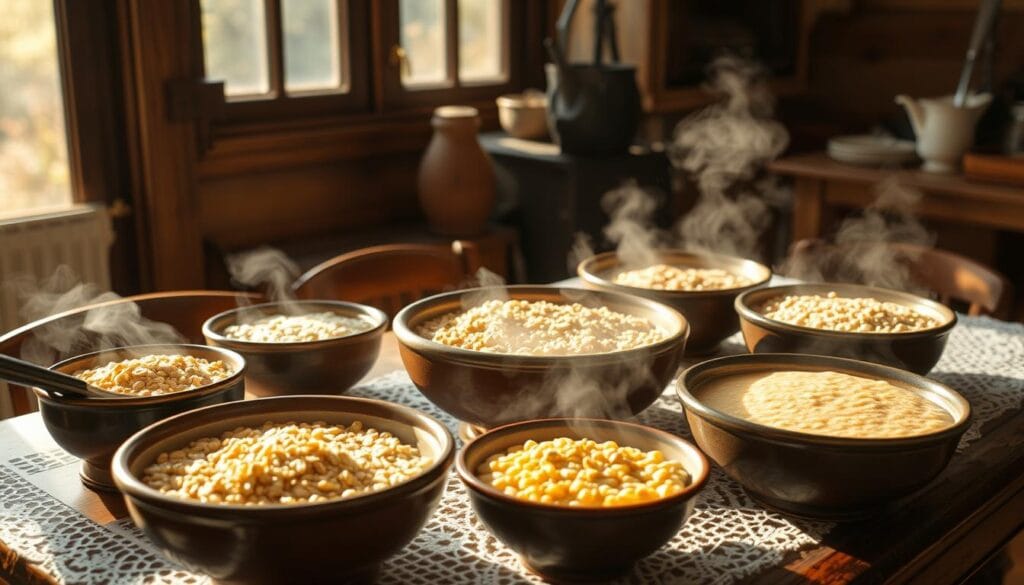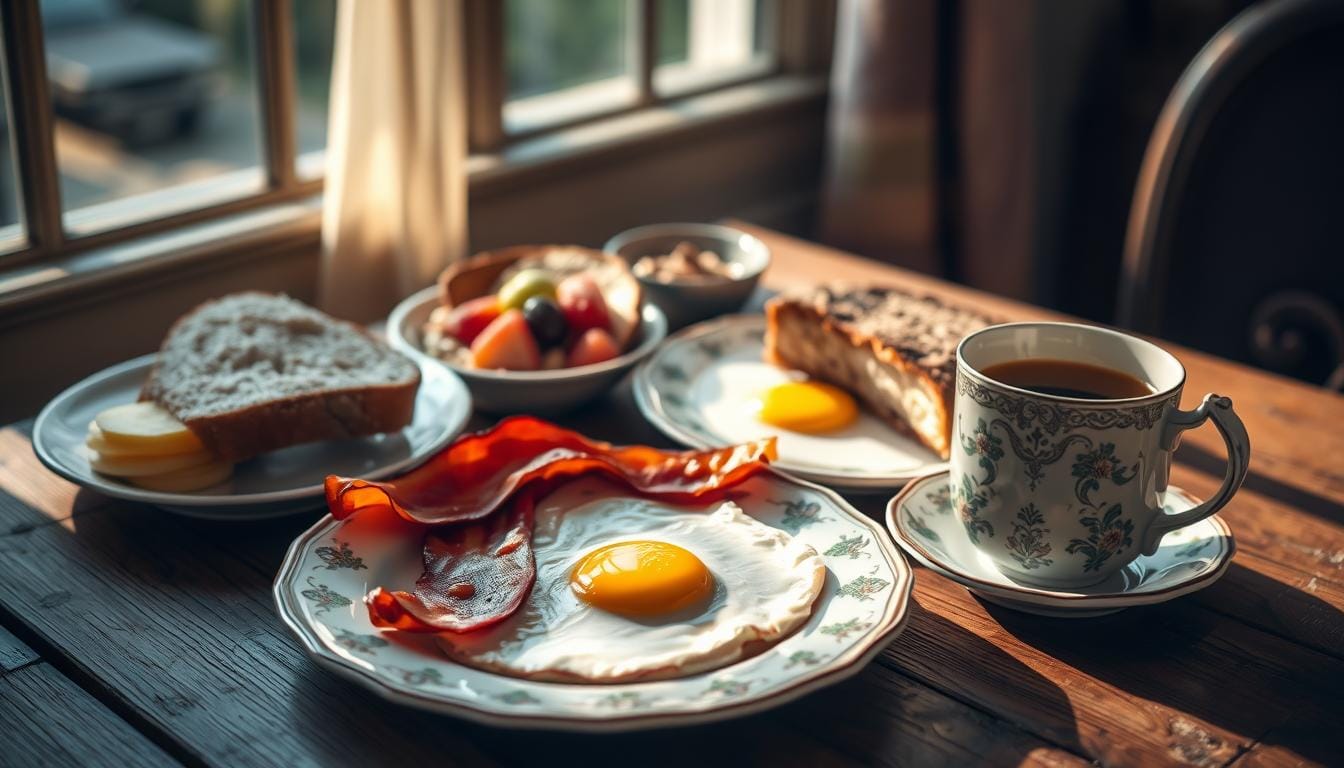ver wondered what was a common breakfast in the 1900s? Breakfast varied greatly depending on where you lived and your social status. In the U.S., working-class folks often had beef sausage, biscuits, coffee, and sugar. Meanwhile, the wealthy enjoyed more elaborate meals like toast, muffins, omelets, and fruit.
Picture starting your day with a breakfast from the 1900s. You might have had granula, the first American cereal, or cream of wheat, a porridge introduced at the 1893 World’s Columbian Exposition. Exploring what was a common breakfast in the 1900s reveals the stories behind these dishes, showing the values and traditions of the time. The 1900s also saw significant changes in breakfasts, thanks to industrialization and new food technologies.
The American Breakfast Table in the 1900s
When you sit down at the breakfast table, you join a tradition that goes back to the 1900s. Back then, the breakfast table was buzzing with activity. Families would come together to enjoy a meal before their day began. The kitchen equipment of that time was key in making these meals, with wood-fired stoves and iceboxes being common.
A typical breakfast in the 1900s included egg beef sausage, bread or toast, and coffee. About 75% of families made these items a part of their breakfast. Breakfast times varied, but most families ate between 6:00 and 8:00 am. The table settings were simple, focusing on what was needed, not how it looked.
Some interesting facts about breakfast in the 1900s include:
- 90% of American households regularly had breakfast
- 40% of Americans ate cereals for breakfast
- 50% of urban families had fresh milk for breakfast
For an in-depth look at breakfast habits in the early 20th century, explore Breakfast in 1910: What Did People Eat? for a nostalgic culinary journey.

Kitchen Equipment of the Era
The kitchen tools of the 1900s were basic. They focused on simple cooking items and appliances. Some common tools were:
- Wood-fired stoves
- Iceboxes
- Cast-iron skillets
Typical Serving Times
Breakfast times various, however most families ate between 6:00 and eight:00 am. This gave them a danger to experience their meal earlier than beginning the day.
Common Table Settings
The table settings for breakfast had been simple. They focused on what became wished, no longer the way it regarded. A traditional putting may encompass:
- A undeniable tablecloth
- Simple plates and utensils
- A centerpiece, like a vase of flora
Popular Breakfast Cereals of the Early Twentieth Century
As you look into the history of breakfast, you’ll see how breakfast cereals became a big part of American homes in the early twentieth century. Cold cereals like Cornflakes and Grape-Nuts changed how people began their day. They were easy to eat and seen as a better choice than meat-heavy breakfasts.
Some of the most popular breakfast cereals back then were:
- Oatmeal
- Cream of Wheat
- Cornflakes
- Grape-Nuts
These cereals were everywhere and became a common choice in many American homes. The rise of breakfast cereals was thanks to food production getting more industrial and new ways of marketing.

The breakfast cereal industry grew fast, with more types of cereals popping up. From about 160 in 1970 to around 340 in 1998, the variety grew a lot. This was because people wanted easy and better options for breakfast. As you keep learning about breakfast history, you’ll see how breakfast cereals really shaped morning routines.
| Year | Number of Breakfast Cereals |
|---|---|
| 1970 | 160 |
| 1998 | 340 |
| 2012 | 5,000 |
Hot Grain Dishes and Porridges
Hot grain dishes offer a variety of choices, like oatmeal and Cream of Wheat. These were common in American homes in the 1900s. To make them, you cook the grains in water or milk and then add toppings.
Popular toppings include sugar, milk, or fruit. You can also add cinnamon or honey for a unique taste. The secret to a great dish is using quality ingredients and trying new toppings.

Other than oatmeal and Cream of Wheat, there are many more options. Try grits or cornmeal mush for a hearty start. Each dish is a tasty way to begin your day.
Oatmeal Preparations
Oatmeal is a favorite that can be made in several ways. You can cook it on the stovetop, in the microwave, or in a slow cooker. Some like to add vanilla or cinnamon, while others prefer it plain.
Cream of Wheat Origins
Cream of Wheat has been around for centuries. It’s made from wheat farina, which is rich in fiber and nutrients. It’s often served with milk, sugar, and fruit, making it a great breakfast option.
Common Grain Toppings
Many toppings can enhance your hot grain dishes. Try fresh or dried fruit, nuts, and seeds. Using different milks, like almond or soy, can also add creaminess and flavor.
The Role of Eggs in Morning Meals
Eggs have been a key part of breakfast for centuries. They hold a special place in morning meals. Eggs were first domesticated in India around 3200 B.C.E. and later brought to North America by Columbus in 1493.
Today, eggs are a favorite for breakfast. You can find dishes like omelets, frittatas, and sunny-side-up eggs in many restaurants.
Eggs are very versatile in breakfast menus. Places like 5350 The Pour House use fresh, local eggs in their dishes. Eggs have been used in baking for thousands of years, starting with Ancient Egypt and Roman cultures.
In fact, one Roman recipe needed one egg for every pound of flour. This shows how important eggs were in ancient baking.
Adding eggs to your breakfast can be a great way to start your day. Whether you like scrambled eggs, egg sandwiches, or omelets, there are many ways to enjoy eggs in a nutritious morning meal.
For inspiration on creative breakfast pairings, visit What Are the Best Buns for Barbecue Sandwiches? to explore delicious bread options
Bread and Toast Variations
Bread and toast are key breakfast items in many homes. In the 1900s, families made their own, adding spreads and toppings for flavor. You can pick homemade or store-bought, each with its own charm. Homemade gives you control over ingredients and texture. Store-bought offers convenience and a variety of flavors.
Popular spreads include butter, jam, and honey. You can also try fresh fruits, nuts, or chocolate. The goal is to find a mix that you love. Whether it’s a classic or something new, bread and toast offer many breakfast options.
Types of Bread
There’s a wide range of breads, each with its own taste and texture. Here are a few favorites:
- White bread: soft and light, a classic choice
- Whole wheat bread: a great option, with a nuttier taste
- Rye bread: denser, darker, with a unique flavor
- Sourdough bread: tangy, chewy, with a special texture
Popular Spreads and Toppings
Spreads and toppings are endless. Here are some favorites:
- Butter: a classic spread, great on toast or bread
- Jam: sweet and fruity, in many flavors
- Honey: a natural sweetener, perfect for toast or yogurt
- Nuts: crunchy and nutritious, adds texture
| Bread Type | Spread/Topping | Description |
|---|---|---|
| White bread | Butter | A classic combination, simple and delicious |
| Whole wheat bread | Jam | A sweet and nutritious option, perfect for toast |
| Rye bread | Honey | A unique and flavorful combination, great for breakfast |
Breakfast Beverages Through the Decades
Exploring breakfast history shows breakfast beverages are key. Over the decades, drinks have changed with tastes and culture. In the early 1900s, coffee and tea were common. Then, juice, like orange juice, became a favorite.
Events like the “Drink an orange” campaign in 1916 boosted orange juice. Quik by Nestle in 1948 made chocolate milk easy to make. Dunkin’ Donuts in 1950 also grew the coffee and breakfast market.
Here are some key milestones in the history of breakfast beverages:
- 1830s: Coffee becomes a staple in American households
- 1916: Orange juice is marketed as a breakfast beverage
- 1948: Quik by Nestle is introduced, allowing for quick chocolate milk preparation
- 1950: Dunkin’ Donuts opens, expanding the coffee and breakfast market
Today, we have many breakfast beverages to choose from. Many prefer green tea or fresh juice for nutrition. Looking back, coffee, tea, and juice are top choices, loved for years.
| Year | Breakfast Beverage | Event |
|---|---|---|
| 1916 | Orange Juice | Marketing campaign “Drink an orange” |
| 1948 | Chocolate Milk | Introduction of Quik by Nestle |
| 1950 | Coffee | Opening of Dunkin’ Donuts |
Regional Differences in American Breakfast Customs
Exploring American breakfast customs shows us how one-of-a-kind regions have their own ways. Each region’s lifestyle and history form its breakfast traditions. This makes American breakfast a mix of flavors and customs.
In New England, breakfasts are hearty with clam chowder and baked beans. This displays the vicinity’s maritime beyond. On the opposite hand, Southern states enjoy bigger breakfasts with meats, grits, and biscuits. This indicates the area’s farming roots
Western Frontier Traditions
The Western Frontier has its very own breakfast fashion, prompted by using cowboy culture. Breakfasts here are simple however filling, with beans, beef sausage, and eggs. These dishes reflect the local components and the vicinity’s history.
Some breakfast objects vary by region:
- Cereals are extra commonplace in northern states.
- Meats and grits are favorites within the south.
- Beans and beef sausage are staples in the Western Frontier.
These differences display the variety and richness of American breakfasts. They highlight the role of local traditions and substances in shaping breakfast.akfasts. They highlight the role of local traditions and ingredients in shaping breakfast.
The Social Significance of Breakfast Time
Breakfast time is special in many cultures. It’s a time for family to gather and bond. Lovefood.com says it’s when families share stories and meals together. The warmth of breakfast comes from the meal prep and the help of domestic staff.
In many homes, breakfast is when families come together. They share meals and talk about their day. This custom helps families feel close and creates memories. Domestic staff are key in making breakfast a joyous time, from cooking to cleaning up.
- Meal preparation: The process of preparing breakfast meals, including cooking, serving, and cleaning up.
- Family gathering: The act of coming together with loved ones to share a meal and socialize.
- Domestic staff: The people responsible for ensuring that breakfast time runs smoothly, including cooking, serving, and cleaning up.
- Social significance: The importance of breakfast time in fostering a sense of community and togetherness.
Family Gathering Customs
Family customs at breakfast are key. They let families share stories and plans. It’s a time to enjoy each other’s company.
Domestic Staff and Meal Preparation
Domestic staff are vital in meal prep. They make sure breakfast is ready and clean up. Their work adds to the warmth of breakfast, making it a special time for everyone.
Food Storage and Preservation Methods
Exploring the 1900s’ culinary traditions shows us how people stored and preserved food. Families used canning, pickling, and smoking back then. These methods kept food safe and available all year.
Drying food started in the Middle East around 12,000 B.C. By the 1800s, icehouses and refrigeration became common in America. Vacuum sealing was also used to keep food fresh longer.
- Canning: Heated foods in jars to destroy microorganisms and inactivate enzymes
- Dehydrated food: Retains about 1/15th of the bulk of the original product, reducing storage requirements
- Freeze-dried food: Has an impressive shelf life of up to 25 years, making it a prime choice for emergency food supplies
- Fermentation: Enhances nutritional value through the action of microorganisms, prolonging shelf life
New “convenience” foods like Jell-O changed breakfast habits. By 1910, Americans ate about 7.5 ounces of breakfast cereals weekly. This shows how processed foods became more popular.
The Impact of Industrial Revolution on Breakfast Foods
The industrial revolution changed breakfast foods a lot. It brought mass production and new ways to process food. People moved from rural to urban areas, changing their eating habits. This led to the creation of breakfast cereals, a big hit in American homes.
According to lovefood.com, the industrial revolution was key in shaping breakfast. Mass production made breakfast foods cheaper and more available. New ways to process food allowed for packaged items like cereals and bread, easy to store and eat.
Mass Production Changes
Mass production changed breakfast foods a lot. Foods like beef sausage and eggs, once luxury items, became more common. Refrigeration and packaging made perishable foods widely available.
New Food Processing Techniques
New ways to process food, like canning and freezing, kept foods fresh all year. This increased breakfast food variety and nutritional value. The industrial revolution also brought new foods, like breakfast cereals, easy to make and eat.
The industrial revolution’s effect on breakfast foods is shown in the table below:
| Food Item | Pre-Industrial Revolution | Post-Industrial Revolution |
|---|---|---|
| Beef Sausage | Luxury item, expensive and hard to find | Mass-produced, affordable, and widely available |
| Eggs | Seasonal and perishable | Available year-round, thanks to refrigeration and packaging |
| Breakfast Cereals | Did not exist | Mass-produced, convenient, and nutritious |
In conclusion, the industrial revolution greatly influenced breakfast foods. It led to new foods, processing methods, and ways to distribute them. These changes have shaped how we eat breakfast today.
Recipe Examples From 1900s Cookbooks
Exploring 1900s cookbooks reveals a variety of historical recipes. These recipe examples give us a peek into the culinary world of the time. You’ll find dishes like chicken pudding, ambrosia, and Jell-O.
The recipe examples from 1900s cookbooks show a preference for simple, filling meals. For example, ambrosia back then was made with just oranges, coconut, and sugar. This simplicity is common in many historical recipes from that era.
Here is a sample of nutritional information for some historical recipes:
| Dish | Calories | Fat | Carbohydrate | Protein |
|---|---|---|---|---|
| Coffee Cake (1 piece) | 242 | 11g | 32g | 3g |
| Broccoli-Beef Puff Pancake (1 piece) | 413 | 25g | 28g | 19g |
| Southern Grits Dish (3/4 cup) | 466 | 34g | 23g | 17g |
These recipe examples from 1900s cookbooks show the simplicity of the era’s cooking. They focus on fresh ingredients and straightforward dishes. By looking at these historical recipes, you can learn more about breakfast traditions from the 1900s.
Conclusion: The Legacy of 1900s Breakfast Traditions
The breakfast habits of the early 1900s tell us a lot about the culture and history of that
ime. The rise of industrialization changed how food was made. This led to the creation of famous dishes like muesli, which is now a staple in many homes.
The 1904 World’s Fair in St. Louis was a big deal. It showed how American tastes were changing. People were eating more fruits, canned goods, and cereals made on a large scale. This was also when Kellogg’s Company started, making breakfast a big deal in society and the economy.
Even today, you can see the influence of 1900s breakfasts in your kitchen and local cafes. Oatmeal, toast, and eggs are all popular because of their roots in the past. When you enjoy your breakfast, remember the long history and evolution behind this beloved American tradition.
FAQ
Q: What was a common breakfast in the 1900s?
A: In the 1900s, breakfasts often included chicken pudding, ambrosia, and Jell-O. These dishes showed the culinary values of the time.
Q: What was the typical American breakfast table like in the 1900s?
A: The 1900s American breakfast table had many kitchen tools and set times. It showed the era’s values and traditions.
Q: What were some popular breakfast cereals in the early twentieth century?
A: Oatmeal and Cream of Wheat were favorites in the early 1900s. Their history and evolution show the era’s culinary traditions.
Q: How were hot grain dishes and porridges prepared and consumed in the 1900s?
A: In the 1900s, hot grain dishes like oatmeal and Cream of Wheat were topped with sugar, milk, or fruit. This was a common breakfast practice.
Q: What was the role of eggs in morning meals during the 1900s?
A: Eggs were key in 1900s breakfasts. They were valued for their taste and nutritional benefits, showing the era’s culinary values.
Q: What types of bread and toast were commonly consumed in the 1900s?
A: People in the 1900s enjoyed homemade and store-bought bread and toast. They were often topped with spreads and other ingredients.
Q: What were the popular breakfast beverages in the 1900s?
A: Coffee, tea, and juice were popular in the 1900s. They changed over time, influenced by cultural and historical events.
Q: How did regional differences influence American breakfast customs in the 1900s?
A: Different regions in the U.S. had their own breakfast traditions in the 1900s. These reflected the unique cultures and histories of each area.
Q: What was the social significance of breakfast time in the 1900s?
A: Breakfast in the 1900s was more than just a meal. It was a time for family gatherings and showed the role of domestic staff in meal prep.
Q: What were the food storage and preservation methods used in the 1900s?
A: In the 1900s, people used canning, pickling, and smoking to keep food fresh. These methods were part of the era’s culinary traditions.
Q: How did the industrial revolution impact breakfast foods in the 1900s?
A: The industrial revolution changed how breakfast foods were made and sold. New production methods and food processing techniques became common.
Q: What are some examples of historical recipes from the 1900s?
A: Recipes from the 1900s include dishes like chicken pudding, ambrosia, and Jell-O. They showcase the culinary traditions of the time.

